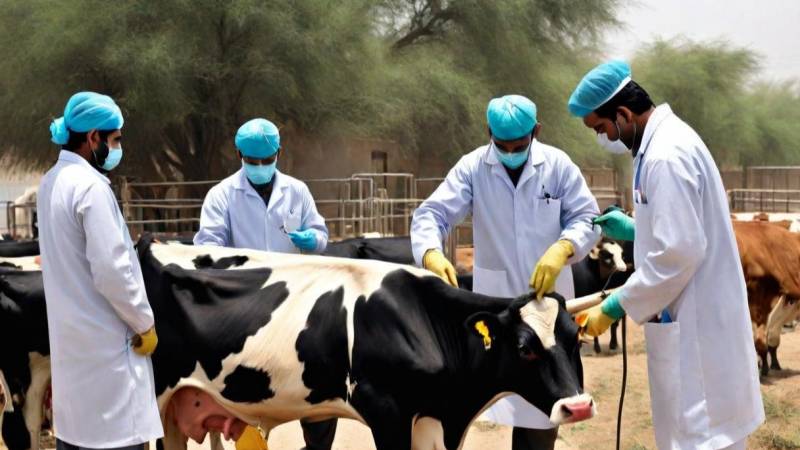
Livestock is an important component of Pakistan's agri-based industry as it contributes significantly to both agricultural productivity and the national economy. However, the growing demand for cattle protein, predominantly meat and milk, has emphasised the challenges faced by the farm economy and management problems therein, as well as the ubiquitousness of animal infections disturbing their reproductive system.
Uterine disorders epitomise a noteworthy reproductive problem in livestock, particularly in milch cattle. Categorised into several types, these infections register the most important effect on the efficacy of reproduction as well as overall production outputs from cattle. Certain problems arise in the premature post-delivery stage, including placenta preservation, ketosis, milk infection, and uterine disorders, which can hinder milk productivity and future reproduction.
Uterine infections, particularly due to Staphylococcus aureus, have turned out to be a key concern in cattle farming. Antibiotic-resistant strains, comprising multi-drug-resistant (MDR) bacteria, are becoming more ubiquitous and are risking the growth and efficiency of the livestock economy. The injudicious use of antibiotics in controlling such diseases has resulted in drug resistance. In the context of Pakistan's current situation, S. aureus strains with antibiotic-resistance have been detected extensively in several livestock, including cows, buffaloes, sheep and goats. This poses a challenge not only to the animal farming industry but also a potential risk to public health since these resistant strains can be transmitted to humans through the consumption of animal products.
Innovative approaches are being explored to evaluate the necessary prerequisites for efficient treatment. Blended therapeutic approaches, including the implementation of non-antibiotic medicines such as non-steroidal anti-inflammatory drugs (NSAIDs) together with resilient antibiotics, are being considered to re-sensitise MDR bacteria. Such combinatory approaches aim to enhance treatment efficiency, reduce drug toxicity, and mitigate the menace of MDR outbreaks.
Our study was designed to determine how the prevalent drug-resistant strains of S. aureus are impacting milch cow reproductive systems. The study was conducted in the districts of Lahore and Kasur in Pakistan. Cutting-edge molecular methods were used in the study to reveal a comprehensive prevalence of ARSA (Aminoglycoside-resistant [S. aureus]) at 36.23%, BRSA (ß-lactam-resistant S. aureus) at 18.84%, CRSA (Ciprofloxacin-resistant S. aureus) at 18.84%, MRSA (Methicillin-Resistant S. aureus) at 37.68%, and TRSA (Tetracycline-resistant S. aureus) at 27.53%. PCR was used to target key resistance genes (aacA-aphD, blaZ, gryA, mecA and tetk). This data is critical in spotting the genomic origin of antibiotic resistance, highlighting the way forward for imminent therapeutic approaches.
As the livestock industry confronts drug-resistant infections due to the widespread use of antimicrobial agents in animals, our research highlights the importance of responsible antibiotic use, the development of novel therapeutic approaches, and the investigation of combination therapies to preserve public health
Phylogenetic analysis aims to understand the isolates' homology patterns as compared to previously reported isolates from various farm animals in Pakistan. Our study reported that the overall prevalence of S. aureus was 17.96%. Risk factor analysis showed that the breed of animal, visible discharge from the vagina, lactation number, insemination procedure, history of reproductive disorders in the past 6-12 months, and calving place showed statistically significant association (p<0.05) with S. aureus-associated with bovine reproductive issues.
To offer insights into prospective therapeutic alternatives, antibiogram profiling of multidrug-resistant isolates and the in vitro antibacterial efficacy of NSAIDs – solitarily as well as in combination with resistant antibiotics – are being investigated. Antibiogram of multi-drug resistant (MDR) S. aureus isolates showed a highly resistant response to penicillin, ceftriaxone, cefotaxime, and amoxiclav. The combination of ceftriaxone with meloxicam and ketoprofen, oxytetracycline-flunixin meglumine, and amoxiclav-flunixin meglumine showed an encouraging synergistic effect. According to the results of our current investigation, NSAIDs and antibiotics together may be used as therapeutic agents to modulate resistance in MDR S. aureus.
As the livestock industry faces the challenge of drug-resistant infections due to the widespread use of antimicrobial agents in animals, our research highlights the importance of responsible antibiotic use, the development of novel therapeutic approaches, and the investigation of combination therapies to preserve public health while ensuring the sustainability and well-being of animal production.

